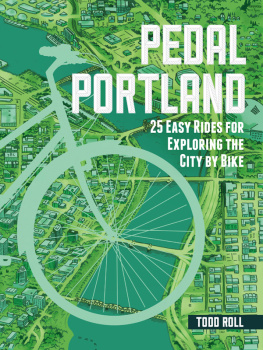Wayne D. Cottrellis an engineering, math, and science educator specializing in transportation. Hes also a researcher, author, runner, cyclist, snowshoer, and orienteerer. He is a member of the Transportation Research Boards Bicycles Committee and has been an active cyclist and member of USA Cycling for twenty-five years. His bicycle racing rsum includes occasional road and mountain bike wins. He won an award for his writing from the National Research Council in 1999. Wayne grew up in the Bay Area, in Oakland. He bicycled to college, then occasionally to work after graduating, and then for recreation and competition, becoming familiar with biking routes throughout California. Wayne is the author of Road Biking Utahand Best Bike Rides guide books for Los Angeles, Orange County, and San Francisco, all FalconGuides; seventeen articles on transportation in refereed technical journals; thirty technical articles in conference proceedings; and a number of transportation research reports. He earned a PhD in transportation engineering from the University of Utah in 1997 and is a registered traffic engineer in California. Wayne is a licensed Category 3 and Masters cyclist with USA Cycling. He currently resides in Searles Valley, California.
This book offers fifteen easy rides, plus ten suggested (also easy) rides, of various lengths and terrain to cover a wide range of abilities. The rides are generally short in length, in keeping with the books easy theme. None of the rides has long or steep climbs. It is nearly impossible to encounter entirely flat routes in the Bay Area, except along the San Francisco Bay. Even the Pacific Coast is rugged, steep, and often inaccessible. Thus, many of the rides feature a few short climbs and descents. The book is designed for entry-level and beginner cyclists and riders who are not prepared for or do not have the time for a long route. Yet, fit cyclists can find some fun and training in doing any of these rides fast, or maybe two or more times in succession.
The geographical definition of the Bay Area varies according to US Census designations. The San FranciscoSan MateoRedwood City metropolitan division includes San Francisco and San Mateo Counties (estimated 2018 population: 1,652,900). San Francisco City and County are contiguous, and San Mateo County is often referred to as the Peninsula. The San FranciscoOaklandBerkeley metropolitan statistical area (MSA) is the well-known five-county Bay Area and includes Alameda, Contra Costa, Marin, San Francisco, and San Mateo Counties (estimated 2018 population: 4,729,500). The San Francisco Bay Area encompasses an equally well-known nine-county region, adding Napa, Santa Clara, Solano, and Sonoma Counties to the MSA. Finally, the San JoseSan FranciscoOakland combined statistical area is a massive fourteen-county region, adding Merced, San Benito, San Joaquin, Santa Cruz, and Stanislaus Counties to the nine-county region (estimated 2018 population: 9,666,100). This book treats San Francisco as the center, emanating from there to incorporate rides in the city, and in Alameda, Contra Costa, Marin, and San Mateo Countiesmost of the five-county region.
San Francisco and San Mateo County, to the south, form the San FranciscoSan MateoRedwood City metropolitan division. The Peninsula cities of Atherton, Belmont, Brisbane, Burlingame, Colma, Daly City, East Palo Alto, Foster City, Half Moon Bay, Hillsborough, Menlo Park, Millbrae, Pacifica, Redwood City, San Carlos, San Mateo, South San Francisco, Woodside, and a number of unincorporated communities (e.g., El Granada, Emerald Lake, Montara, Moss Beach, Princeton-by-the-Sea) are distinguished from other Bay Area cities by their direct access to San Francisco (i.e., no need to cross a bridge). It was from Sweeney Ridge, in the mountains northeast of Half Moon Bay, that Gaspar de Portol sighted San Francisco Bay in 1769. The Santa Cruz Mountains run north-south through San Mateo County, effectively splitting the county into western and eastern sides. Urbanization is concentrated on the east side; development is less extensive in the west. The mountains remain mostly undeveloped, with a large portion devoted to the San Francisco State Fish & Game Refuge. Airplanes land at and take off from San Francisco International Airportwhich is in San Mateo Countyon a constant basis, making the airport the seventh-busiest in the United States. To the south, on the east side, are Santa Clara County and Silicon Valley. To the southwest is Santa Cruz County. At the hub, to the north, is San Francisco (SF). Six of the books rides are in SFa seventh ride enters SF from Alameda County; San Mateo County rides are in Brisbane and South San Francisco, the Half Moon Bay area, and Redwood City. The concentration of rides in SF is in line with the books title. But SF is a great cycling city. Despite the citys hills, there is an extensive network of bike routes and accommodations for bikes. Cycling guides instruct riders on how to avoid the steepest hills. The well-known Critical Mass movement, now nationwide, started in SF. And the citys bike messengers are some of the fastest and most daring around.
Start:Brisbane Lagoon Fishermans Park, Sierra Point Parkway, Brisbane




